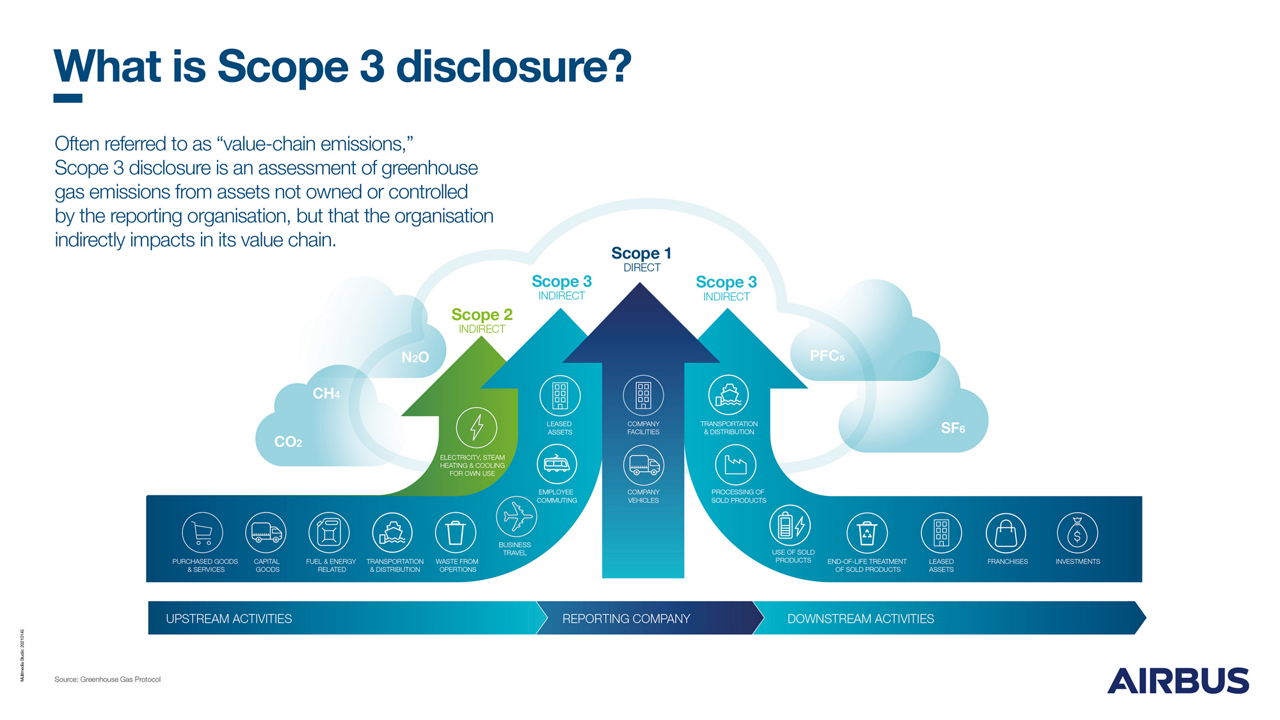As part of its non-financial reporting, Airbus has extended its disclosure to include the in-use emissions of commercial aircraft delivered in 2019 and 2020 (Scope 3 - Use of sold products). In doing so, Airbus is the first aircraft manufacturer to disclose the emissions produced by its products during their operation.
In line with its purpose to pioneer sustainable aerospace for a safe and united world and with its ambition to play a leading role in the decarbonisation of the aviation sector, Airbus has decided to extend its greenhouse gas reporting to include CO2 emissions produced by its commercial aircraft during their operating phase — also known as "Scope 3 - Use of sold products" emissions as part of the Greenhouse Gas Protocol.
By taking this significant step, Airbus becomes the first aircraft manufacturer to report on the emissions generated by its products during their entire lifecycle. Airbus recognises its role in contributing to the reduction of aviation’s global environmental footprint, and therefore strives to achieve the highest level of transparency in its environmental reporting.

- 2019: Airbus delivered 863 commercial aircraft. Based on an average in-service lifetime of approximately 22 years, the total CO2 emissions for these products over their anticipated lifetime is estimated at approximately 740 MtCO2e — 130Mt of which are linked to upstream fuel production. This translates to an average efficiency of 66.6 gCO2e per passenger kilometre.
- 2020: Airbus delivered 566 commercial aircraft. The total anticipated lifetime CO2 emissions for these products is estimated at approximately 440 MtCO2e — 80Mt of which are linked to upstream fuel production. This translates to an average efficiency of 63.5 gCO2e per passenger kilometre.
For the purposes of this calculation, the operating conditions of the aircraft were considered to be static over the entire service lifespan. As such, the figures cited above do not reflect the anticipated gradual introduction of decarbonisation measures, such as sustainable aviation fuels (SAF) and hydrogen. In terms of carbon intensity, the disclosure likely constitutes a “worst-case scenario.” This unmitigated scenario will serve as a basis to assess carbon-emission efficiency improvements over time.
The emission-calculation methodology was developed by a joint team comprising key personnel from Airbus’ Engineering and Environment departments. It is fully aligned with the guidance provided by the Greenhouse Gas Protocol. An external auditor performed a review of the calculation methodology applied by Airbus and assessed the soundness of the supporting assumptions.
A number of assumptions— based on internal and external information, and publicly available data— forms the basis of this methodology. These assumptions include the following:
- Aircraft load factor
- Current penetration of SAF and its CO2 reduction potential
- Indirect emissions index for jet fuel production
- Emissions factor
- Aircraft operational usage and average in-service lifetime
- Airbus primary data (i.e. type of SAF considered or aircraft performance and configuration parametres)


